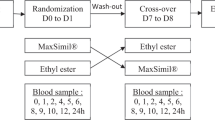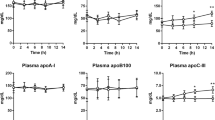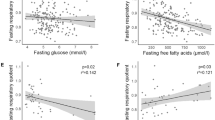Abstract
Objective: To examine the effect of age and gender on the metabolic disposal of [1-13C] palmitic acid.
Design: Cross-sectional.
Setting: Clinical Nutrition and Metabolism Unit at Southampton General Hospital, Institute of Human Nutrition, University of Southampton.
Subjects and measurements: Twelve children (5 boys and 7 girls; aged 5–10 y) and six men (BMI 23.3±2.6 kg/m2; aged 20–30 y) were recruited. Following oral administration of a bolus dose of [1-13C]palmitic acid (10 mg/kg body weight) consumed with a test meal (1667 kJ) the excretion of 13C-label was measured on breath as 13CO2 over 24 h and in stool over 5 d to account for differences in absorption of [1-13C]palmitic acid. The 13C-enrichment of samples was determined by continuous flow-isotope ratio mass spectrometry. Net substrate oxidation was estimated from gaseous exchange measurements in the postabsorptive state and over 6 h postprandially.
Results: The excretion of 13CO2 on breath varied between subjects both in the pattern and amount excreted over 24 h. Breath 13CO2 was not different between boys (61.0±22.4% of absorbed dose) and girls (54.2±17.9% of absorbed dose). The excretion of breath 13CO2 was less in the men (35.1±9.3% of absorbed dose; P=0.005) and that observed previously by our group in women (30.7±6.7% of absorbed dose; P=0.005) than in the children. Net fat oxidation was greater in the children in both the postabsorptive (2.43±0.78 g/h) and postprandial (11.89±3.13 g/6 h) states than in the men (0.93 g/h±1.50; P=0.016; 9.86±10.53 g/6 h; NS) and women studied previously (0.53±0.68 g/h; P=0.003; 0.03±3.21 g/6 h; P=0.001).
Conclusions: Our observations that children oxidised nearly twice the amount of [1-13C] palmitic acid than adults in conjunction with greater net fat oxidation in children than adults in both the postabsorptive and postprandial states should be considered before current UK dietary recommendations for fat and saturated fats, developed for adults, are applied to growing children. For dietary recommendations to be developed further more information is required, particularly in groups of infants and the elderly, about the factors that influence the postprandial handling of dietary fat.
Sponsorships: This work was supported by The Ministry of Agriculture, Fisheries and Food, Scientific Hospital Supplies, UK Ltd. and The Wessex Medical Trust.
This is a preview of subscription content, access via your institution
Access options
Subscribe to this journal
Receive 12 print issues and online access
$259.00 per year
only $21.58 per issue
Buy this article
- Purchase on Springer Link
- Instant access to full article PDF
Prices may be subject to local taxes which are calculated during checkout
Similar content being viewed by others
Author information
Authors and Affiliations
Rights and permissions
About this article
Cite this article
Jones, A., Murphy, J., Stolinski, M. et al. The effect of age and gender on the metabolic disposal of [1-13C]palmitic acid. Eur J Clin Nutr 52, 22–28 (1998). https://doi.org/10.1038/sj.ejcn.1600501
Received:
Revised:
Accepted:
Published:
Issue Date:
DOI: https://doi.org/10.1038/sj.ejcn.1600501



